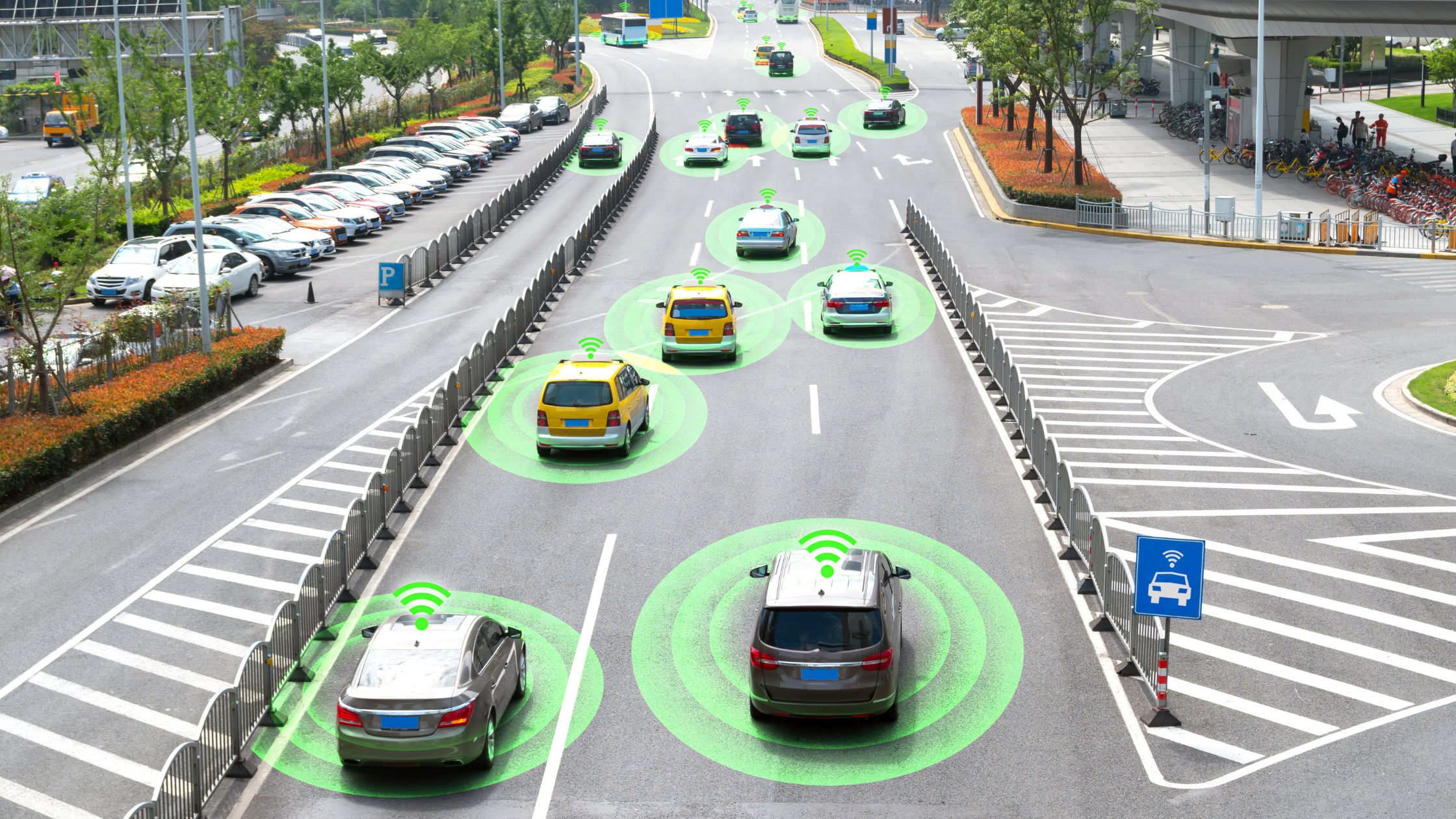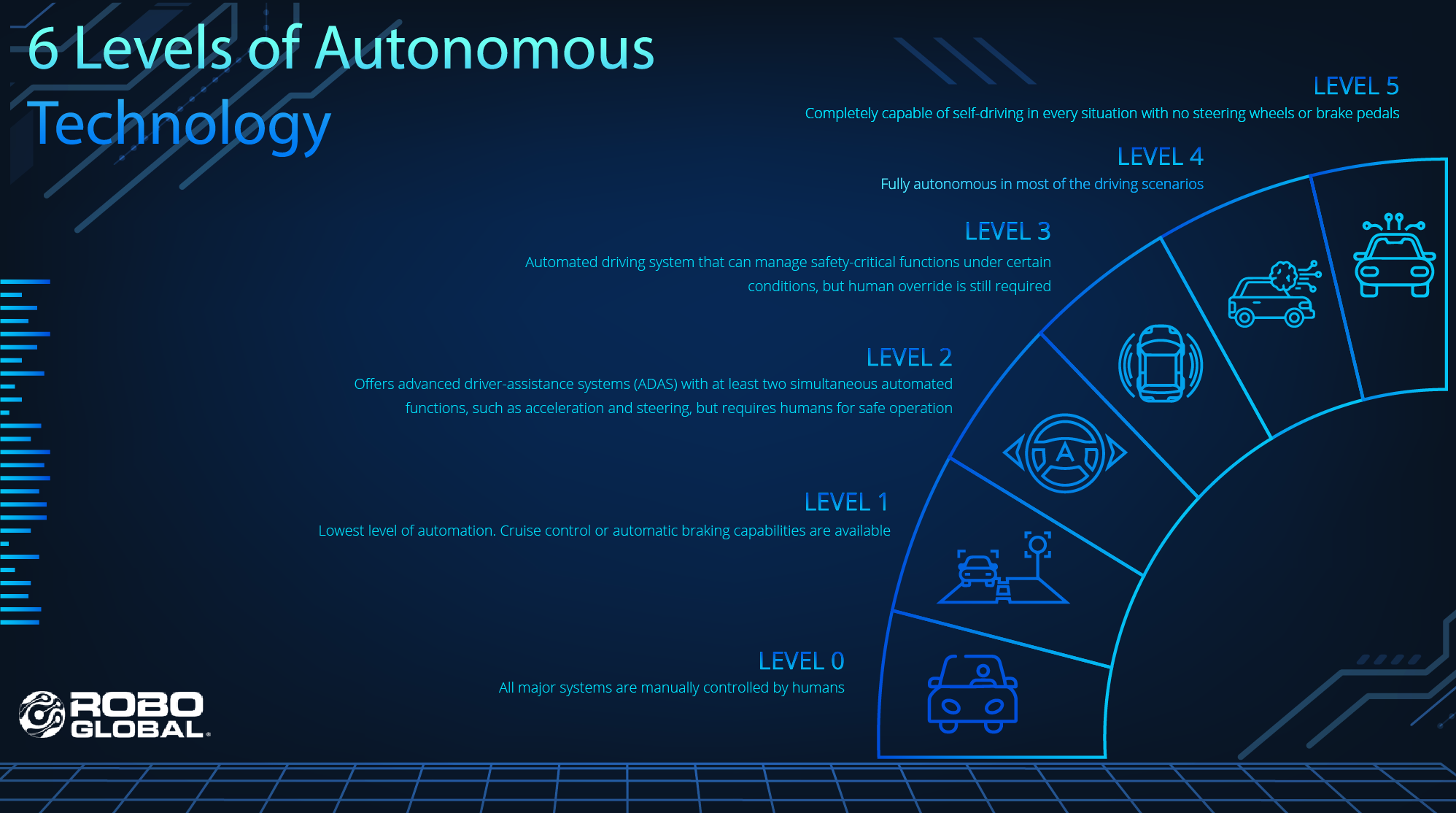Many technology investors are finding themselves asking when we will see fully autonomous vehicles hit the road. The following is a look at how self-driving technologies work, the key players, possible adoption hurdles, and the latest emerging technologies that investors can turn to in order to help capture the growth of the autonomous vehicle market.
Today, there are no legally operating, fully autonomous cars or delivery trucks available for purchase in the world. (Even Waymo’s vehicles are company-owned and not available for sale to the public.) While the hardware technologies required to enable fully autonomous vehicles (AV) are already available, the software components required to enable safe, reliable self-driving technology are evolving rapidly but are still in development. What has been delivered are semi-autonomous vehicles that feature varying levels of automation, such as lane drift correction, autonomous parallel parking, adaptive cruise control, and autonomous emergency braking. Progress is being made, but the leap from where we are today to full autonomy will require more than technology alone.
While fully autonomous driving may still be many years away (at least for those of us who don’t reside in Arizona), major players in the auto industry are already using the power of autonomous technology to reinvent how we use and interact with cars. Consumer demand for greater mobility, smarter vehicles, seamless connectivity, and a more convenient driving experience has steadily increased, spurring an investment of more than $25B1 in autonomous technology solutions in the past three years alone. The stage has been set for massive industry transformation—whether we like it or not.
According to Allied Market Research, the global autonomous vehicle (AV) market is projected to rise from $54B in 2019 to $557B by 2026, a CAGR of nearly 40%. To help investors capture this growth, the ROBO Global Artificial Intelligence Index (THNQ) includes several leaders in the mobility industry, both new players and incumbents, that are delivering the innovations to enable autonomous vehicles. It is these innovators, using the power of AI, that are enabling a digital transformation that will alter many aspects of our lives—including how we drive. Though we are still in the very early innings, the market opportunity is enormous. Here is a snapshot of the industry today. Want to read the full report? Download our investor's guide to self-driving vehicles below.
Key Facts About the AV Industry:
-
- Massive advancements in technology and connected devices have driven automakers and technology companies to compete in the race to develop autonomous vehicles and mobility platforms.
- Automakers are aggressively building strategies using autonomous software and hardware to accelerate investments and stay ahead in the industry. Using AI-enabled deep learning algorithms to train the computing platforms is necessary for fully autonomous solutions.
- Industrial fleets are already using a variety of AVs, including driverless forklifts, agricultural drones, and farm tractors, all of which rely on machine learning technologies and next-generation sensors developed by companies like Google, Nvidia, Xilinx, Infineon, and Appen—all members of the THNQ Index.
- The entire auto industry is seeing a massive transformation and reformation due to major partnerships and collaborations with technology companies that are a direct result of the AI and automation revolution.
- Billions of dollars have been spent on autonomous vehicle research, M&A, and funding, but not every venture has been fruitful, and many challenges remain.
- Regulations are coming. Technology companies and key automakers are working closely with government bodies to share data and safety protocols. Some technology developers are self-regulating in anticipation of stricter policies.
- The US and Europe are currently leading the AV revolution, but China, Japan, and Singapore are catching up in the development of safety regulations and autonomous vehicle (AV) adoption.
- Self-driving technology is finally emerging from the research and development stage, and use cases and the speed of innovation—especially for software platforms powered by AI engines—are growing rapidly, pushing us closer and closer to Level 5 Autonomy using safe, reliable machines. (Read more on Level 5 Autonomy below.)
When will level five autonomy be available?
Level 5 Autonomy is the goal of most automakers, but the highest levels achieved to date, at least commercially, are Level 3. Conventional autopilot technology falls under Level 2, with the ability to detect some objects and do basic classification to help the driver with hazardous conditions. Newer level 3 platforms, including Tesla’s Autopilot, Audi’s A8L, Polestar’s Pilot Assist, and Nissan’s Pro Pilot, take driver assistance to the next level by offering partial ‘hands off’ and ‘eyes off’ capabilities. Only Waymo One currently offers Level 4 and 5 autonomy today.
We at ROBO Global expect that true Level 5 autonomy may be as much as +10 years away, but we expect to see strong use cases and industry impact over the next 3-5 years. Waymo One’s historical launch should demonstrate not only that the technology works, but also that it can be used safely in some environments—and that there is consumer demand for fully autonomous vehicles.
What are the challenges of AV technology?
While we are seeing evidence of tremendous progress over the past few years, the industry still faces many complexities and challenges before mainstream adoption of AVs is possible. The supporting technologies must go through the development, pilot, and commercialization stages before they can be applied commercially, and many of them are still in the development to piloting stages. According to our ROBO Global Strategic Advisors, the complexity of the required software and hardware increases exponentially the closer the system is to becoming fully autonomous.
In order to move beyond today’s semi-autonomous solutions to achieve Level 4 or Level 5 autonomy, the industry faces a number of significant hurdles, including the need for more advanced technology, higher-quality AI datasets to feed the neural networks to train the vehicles, a lack of regulatory framework, and the ability to offer AVs at a commercially viable price point.
Self-driving car stocks to watch
As with any emerging technology, the evolution of autonomous vehicles has created a dynamic field of players. While the following companies are the current leaders, we expect the dominant names to shift over time and investors looking to capture the self-driving revolution should keep a diversified portfolio for that reason. Our ROBO Global Index Methodology is designed to capture these changes as they occur in the ROBO Global Artificial Intelligence Index (ticker: THNQ). Here are a few of the current leaders when it comes to the development of autonomous vehicles:
-
-
- Waymo (GOOGL-THNQ member)
- Cruise (GM)
- Tesla (TSLA-THNQ member)
- Appen (APPN-THNQ member)
- Ford (F)
- Microsoft (MSFT-THNQ member)
- BMW (BMWYY)
- Baidu (BIDU-THNQ member)
-
RELATED: Self-Driving Car Companies for Investors Looking to Tap Into AV Tech
Fully autonomous vehicles require extremely reliable, high performance, power-efficient, adaptive computing solutions. Leading chip providers include Xilinx (XLNX-THNQ member), Nvidia (NVDA-THNQ member), and Infineon (IFX-THNQ member). All of the leading automakers have mapped out their architecture with accelerators, controllers, and GPU/CPU processors for data processing with leading-edge solutions from these top chip makers. These THNQ members play a very significant role in enabling autonomous/ADAS platforms, sensors, and electrification.
What's the investment outlook for self-driving cars?
There are many complexities that must be addressed before truly autonomous self-driving cars will be a reality for the public. New technologies must be developed, tested, and made commercially available. Regulations must be put into place to ensure human safety. And we humans must reach a point where we are at ease entrusting a computer to be behind the wheel of a vehicle holding our most precious cargo: ourselves.
In short, it is likely to take another decade—at least—before we will see Level 5 cars taking over our highways and byways. But with so many key players running an intense race to launch a viable self-driving car, autonomy will most certainly become a reality. There is no doubt that automakers will succeed in their quest to deliver a safe, reliable, and regulated self-driving car.
Over the next several years, we expect to see more strategic collaborations among automakers and AV technology providers; partnerships will be formed and a slew of M&A opportunities will arise. We also anticipate a rapid evolution of the auto industry, built largely on the active investments in AI software platforms by many of today’s legacy automakers and technology companies. Their commitment to delivering on the promise of self-driving cars—and their desire to win the race to market leadership—will make the AV market a reality. ROBO Global’s Artificial Intelligence Index (THNQ) is designed to fully capture this potential for growth, and to offer investors direct exposure to what will be the auto industry revolution of the century.
By: Lisa Chai, Sr. Research Analyst







